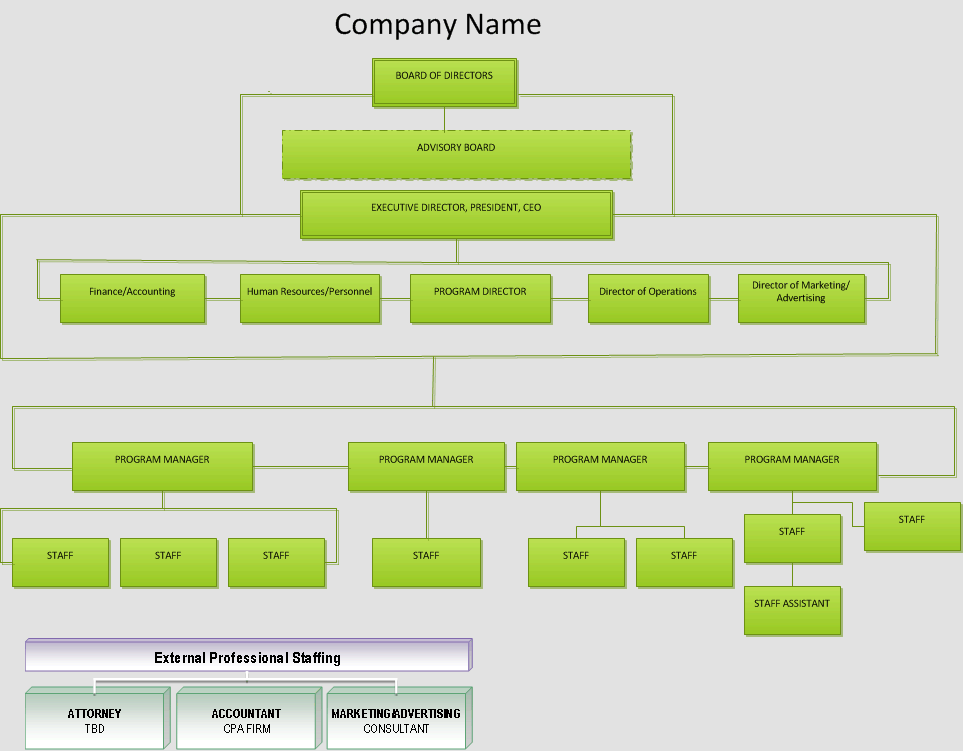The Traditional Structure of a Non-Profit agency is shown in the image. Your organizational chart may look different depending on the age of the agency, the purpose the agency serves and of course, the agency’s budget.
The budget comes into consideration because you will need the necessary funding to support the paid positions in the organization.
To an extent the type of structure you choose will be determined by what you do. Organizations can be structured in various ways:
- By Function, Such As Operations, Marketing, Finance, Fundraising
- By Region
- By Product, Such As Training, Support, Consultancy, Delivery
- In Work Teams, Such As Client/Customer Groups.
In our illustration we are using a functional organization chart.
Let’s take a look at the most common small-medium sized agency positions shown in the chart.
Board of Directors: In organizations of all kinds, good governance starts with the board of directors. The board’s role  and legal obligation is to oversee the administration (management) of the organization and ensure that the organization fulfills its mission. Good board members monitor, guide, and enable good management; they do not do it themselves. The board generally has decision-making powers regarding matters of policy, direction, strategy, and governance of the organization.
and legal obligation is to oversee the administration (management) of the organization and ensure that the organization fulfills its mission. Good board members monitor, guide, and enable good management; they do not do it themselves. The board generally has decision-making powers regarding matters of policy, direction, strategy, and governance of the organization.
The board of a well-governed nonprofit organization, like the board of a well-governed profit-making company, will do all of the following:
- Formulate key corporate policies and strategic goals, focusing both on near-term and longer-term challenges and opportunities.
- Authorize major transactions or other actions.
- Oversee matters critical to the health of the organization— not decisions or approvals about specific matters, which is management’s role—but instead those involving fundamental matters such as the viability of its business model, the integrity of its internal systems and controls, and the accuracy of its financial statements.
- Evaluate and help manage risk.
- Steward the resources of the organization for the longer run, not just by carefully reviewing annual budgets and evaluating operations but also by encouraging foresight through several budget cycles, considering investments in light of future evolution, and planning for future capital needs.
- Mentor senior management; provide resources, advice and introductions to help facilitate operations.
Here you see why it is important to choose board members that will be an asset to your organization and that the board members are not put in place to just fill requirements by funding sources and federal and state regulations for 501 (c) entities.
 Executive Director: This role may choose other titles such as President or CEO and a lot of times is the Founder of the Organization; however the title Executive Director is usually associated with small Non-Profits where the other two titles are used in medium to large organizations. So, depending on the size of the organization it may have a CEO, President and an Executive Director. These positions can be paid or un-paid positions. For our purpose we will use the Executive Director as the overall manager of the organization responsible to the board of directors.
Executive Director: This role may choose other titles such as President or CEO and a lot of times is the Founder of the Organization; however the title Executive Director is usually associated with small Non-Profits where the other two titles are used in medium to large organizations. So, depending on the size of the organization it may have a CEO, President and an Executive Director. These positions can be paid or un-paid positions. For our purpose we will use the Executive Director as the overall manager of the organization responsible to the board of directors.
In the startup organization the founder needs to determine his or her role within the organization.
The most difficult thing to realize is that you are not be the owner of the organization. As a tax-exempt organization your nonprofit will be accountable to the people it serves, to its funders, the attorney general, and the general public.
If you feel that this lack of total control is impossible to accept, you should consider forming your own business where you alone can make all the strategic decisions. Naturally a founder is an important figure in the organization, deserving respect and gratitude but ultimately there is no such position as a ‘founder.’ Every founder has a choice to be part of the staff or part of the board.
If you are most interested in being part of the daily activities in the organization, you may determine to be the executive responsible for the operations, management, and administration of the agency; however, you will report to the board and the board is responsible for assessing your performance and giving you the strategic direction.
If the organization is not able to hire staff right away, you may have a working board where each member has individual fiduciary and governing duties as a board member and individual tasks and responsibilities to carry on the daily activities of the organization. The important issue is to remember which hat each member is wearing at the different times to keep accountability intact. The board makes decisions as a body; individual members are accountable and responsible for their own tasks.
The positions listed above are the two most important positions for a startup and young organization. As the agency grows the additional positions shown in the chart can be filled as the need requires and the funding sources allow. They are listed here for an example of traditional Non-Profit Organizational structures. Your structure can vary.
We will cover the other listed positions in a separate post where we will give suggested job descriptions for each and cover some intermediary positions as well.
Advisory Board: The board of directors of a nonprofit organization is its legal, governing body. In contrast, an advisory board does not have any formal legal responsibilities. Rather, an advisory board is sought by the organization to give advice and support. The appointed advisory board will have a specific defined role such as advisories for fundraising, operations, marketing, etc. We will not cover this in depth since the focus of our blog is on new, small and medium sized organizations who may not utilize a formal advisory board.
The advisory board is included on the org chart to show the relationship of the advisory board to the entire structure of the agency. It is shown with a dashed outline to depict it’s non- governing position in the agency and it is not a requirement.
If you would like more information on anything we have covered here an excellent source of information can be found at Blue Avocado.


